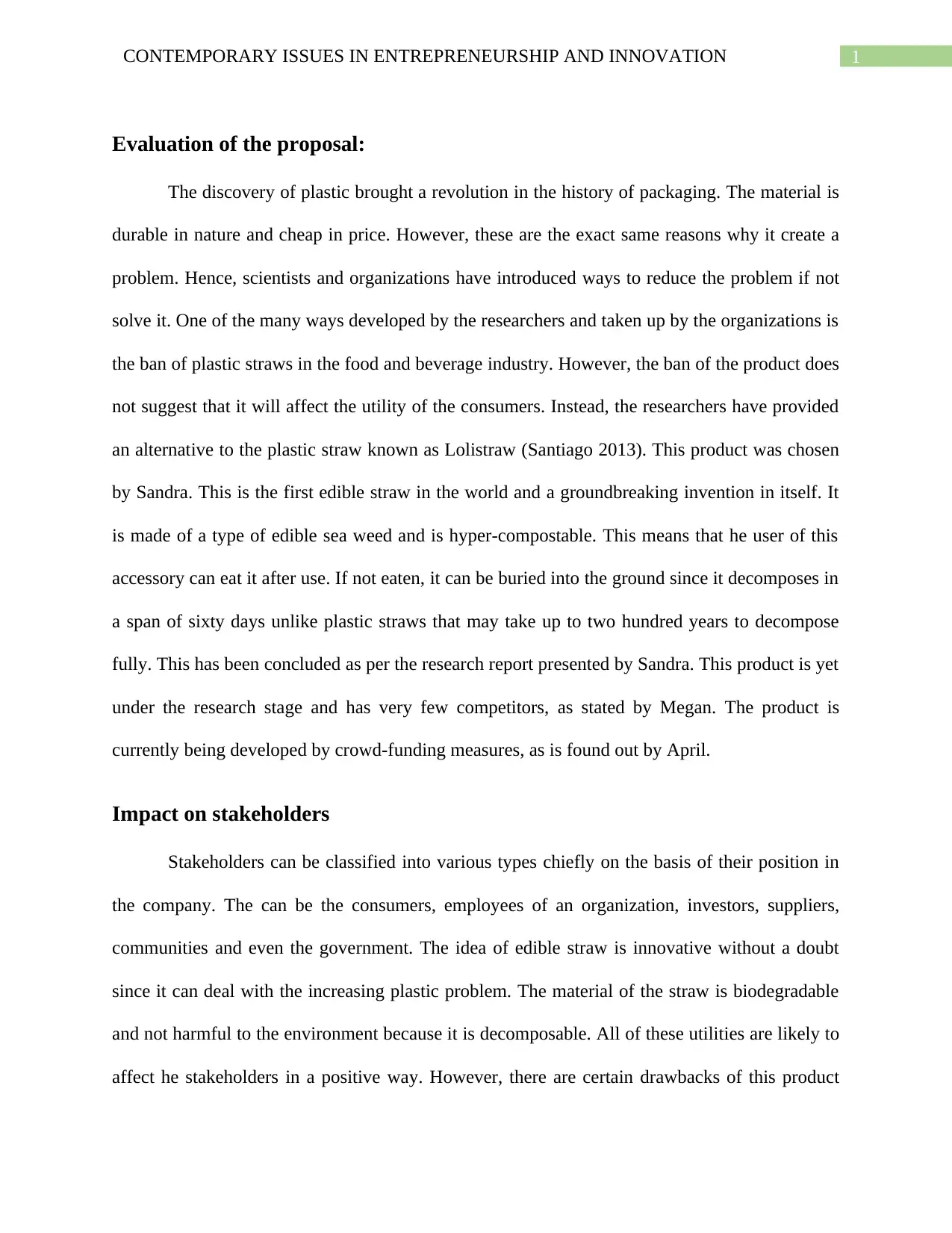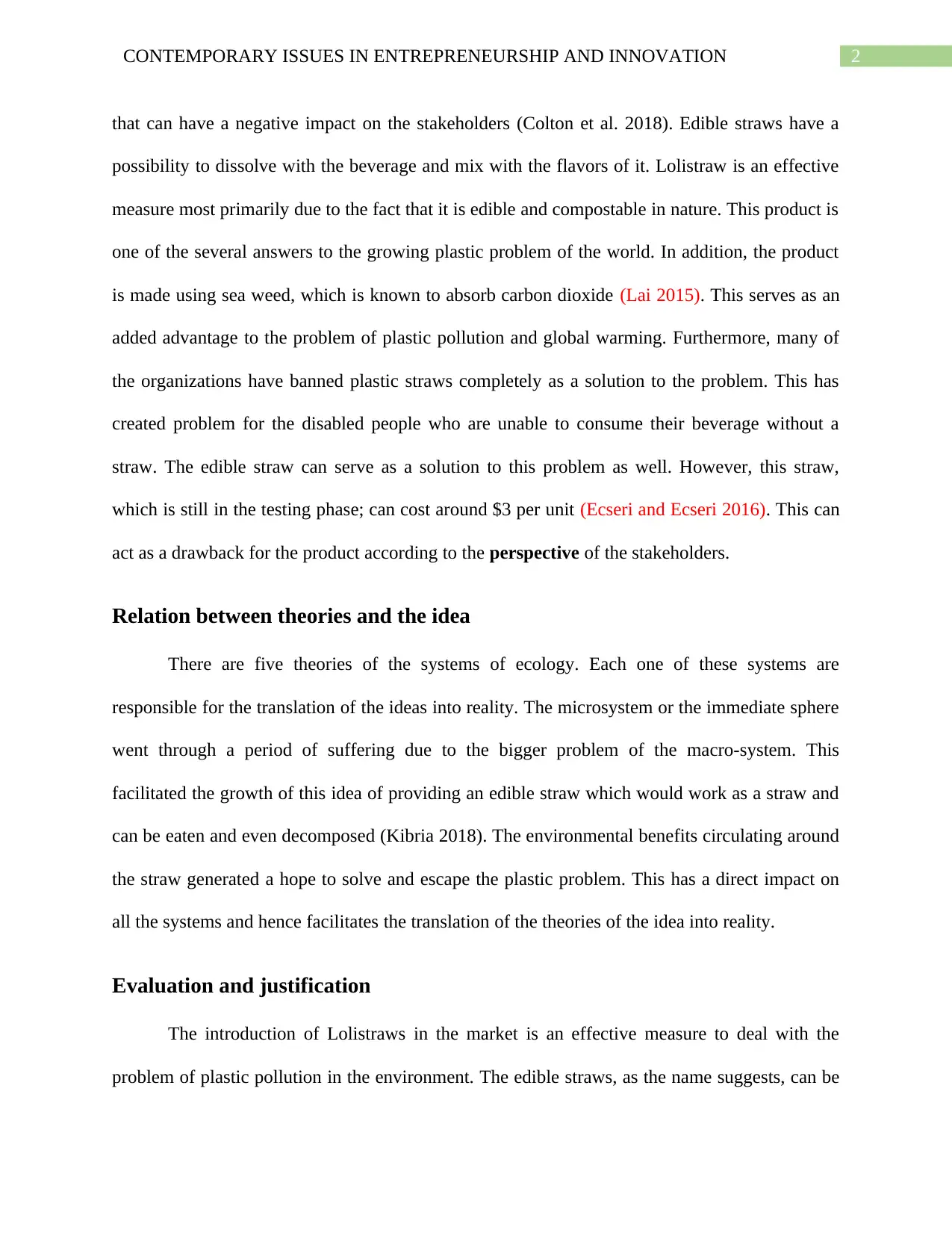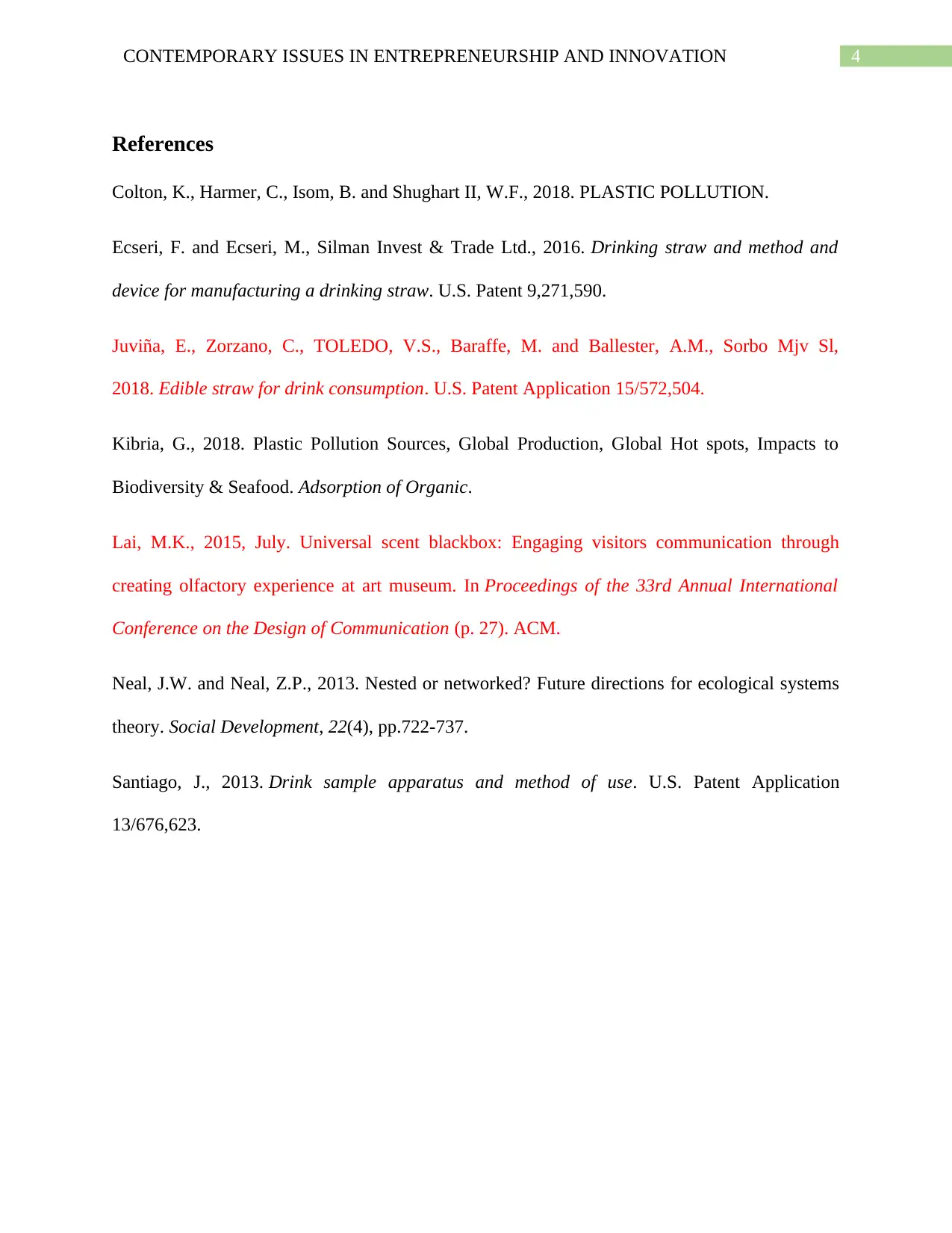ENT30010: Contemporary Issues in Entrepreneurship - Lolistraw Report
VerifiedAdded on 2023/06/07
|5
|1208
|445
Report
AI Summary
This report evaluates the Lolistraw, an edible straw designed to combat plastic pollution, within the context of contemporary issues in entrepreneurship and innovation. It explores the product's impact on stakeholders, including consumers, employees, investors, and the environment, considering both its benefits and drawbacks. The report relates the Lolistraw concept to ecological systems theories, highlighting its potential to address the plastic problem and global warming. While acknowledging limitations such as potential flavor alteration and cost, the report concludes that Lolistraw represents a sustainable alternative to plastic straws and a step towards reducing plastic pollution. Desklib provides access to this report and other valuable study resources for students.

Running head: CONTEMPORARY ISSUES IN ENTREPRENEURSHIP AND INNOVATION
Contemporary issues in entrepreneurship and innovation
Name of Student:
Name of University:
Author Note:
Contemporary issues in entrepreneurship and innovation
Name of Student:
Name of University:
Author Note:
Paraphrase This Document
Need a fresh take? Get an instant paraphrase of this document with our AI Paraphraser

1CONTEMPORARY ISSUES IN ENTREPRENEURSHIP AND INNOVATION
Evaluation of the proposal:
The discovery of plastic brought a revolution in the history of packaging. The material is
durable in nature and cheap in price. However, these are the exact same reasons why it create a
problem. Hence, scientists and organizations have introduced ways to reduce the problem if not
solve it. One of the many ways developed by the researchers and taken up by the organizations is
the ban of plastic straws in the food and beverage industry. However, the ban of the product does
not suggest that it will affect the utility of the consumers. Instead, the researchers have provided
an alternative to the plastic straw known as Lolistraw (Santiago 2013). This product was chosen
by Sandra. This is the first edible straw in the world and a groundbreaking invention in itself. It
is made of a type of edible sea weed and is hyper-compostable. This means that he user of this
accessory can eat it after use. If not eaten, it can be buried into the ground since it decomposes in
a span of sixty days unlike plastic straws that may take up to two hundred years to decompose
fully. This has been concluded as per the research report presented by Sandra. This product is yet
under the research stage and has very few competitors, as stated by Megan. The product is
currently being developed by crowd-funding measures, as is found out by April.
Impact on stakeholders
Stakeholders can be classified into various types chiefly on the basis of their position in
the company. The can be the consumers, employees of an organization, investors, suppliers,
communities and even the government. The idea of edible straw is innovative without a doubt
since it can deal with the increasing plastic problem. The material of the straw is biodegradable
and not harmful to the environment because it is decomposable. All of these utilities are likely to
affect he stakeholders in a positive way. However, there are certain drawbacks of this product
Evaluation of the proposal:
The discovery of plastic brought a revolution in the history of packaging. The material is
durable in nature and cheap in price. However, these are the exact same reasons why it create a
problem. Hence, scientists and organizations have introduced ways to reduce the problem if not
solve it. One of the many ways developed by the researchers and taken up by the organizations is
the ban of plastic straws in the food and beverage industry. However, the ban of the product does
not suggest that it will affect the utility of the consumers. Instead, the researchers have provided
an alternative to the plastic straw known as Lolistraw (Santiago 2013). This product was chosen
by Sandra. This is the first edible straw in the world and a groundbreaking invention in itself. It
is made of a type of edible sea weed and is hyper-compostable. This means that he user of this
accessory can eat it after use. If not eaten, it can be buried into the ground since it decomposes in
a span of sixty days unlike plastic straws that may take up to two hundred years to decompose
fully. This has been concluded as per the research report presented by Sandra. This product is yet
under the research stage and has very few competitors, as stated by Megan. The product is
currently being developed by crowd-funding measures, as is found out by April.
Impact on stakeholders
Stakeholders can be classified into various types chiefly on the basis of their position in
the company. The can be the consumers, employees of an organization, investors, suppliers,
communities and even the government. The idea of edible straw is innovative without a doubt
since it can deal with the increasing plastic problem. The material of the straw is biodegradable
and not harmful to the environment because it is decomposable. All of these utilities are likely to
affect he stakeholders in a positive way. However, there are certain drawbacks of this product

2CONTEMPORARY ISSUES IN ENTREPRENEURSHIP AND INNOVATION
that can have a negative impact on the stakeholders (Colton et al. 2018). Edible straws have a
possibility to dissolve with the beverage and mix with the flavors of it. Lolistraw is an effective
measure most primarily due to the fact that it is edible and compostable in nature. This product is
one of the several answers to the growing plastic problem of the world. In addition, the product
is made using sea weed, which is known to absorb carbon dioxide (Lai 2015). This serves as an
added advantage to the problem of plastic pollution and global warming. Furthermore, many of
the organizations have banned plastic straws completely as a solution to the problem. This has
created problem for the disabled people who are unable to consume their beverage without a
straw. The edible straw can serve as a solution to this problem as well. However, this straw,
which is still in the testing phase; can cost around $3 per unit (Ecseri and Ecseri 2016). This can
act as a drawback for the product according to the perspective of the stakeholders.
Relation between theories and the idea
There are five theories of the systems of ecology. Each one of these systems are
responsible for the translation of the ideas into reality. The microsystem or the immediate sphere
went through a period of suffering due to the bigger problem of the macro-system. This
facilitated the growth of this idea of providing an edible straw which would work as a straw and
can be eaten and even decomposed (Kibria 2018). The environmental benefits circulating around
the straw generated a hope to solve and escape the plastic problem. This has a direct impact on
all the systems and hence facilitates the translation of the theories of the idea into reality.
Evaluation and justification
The introduction of Lolistraws in the market is an effective measure to deal with the
problem of plastic pollution in the environment. The edible straws, as the name suggests, can be
that can have a negative impact on the stakeholders (Colton et al. 2018). Edible straws have a
possibility to dissolve with the beverage and mix with the flavors of it. Lolistraw is an effective
measure most primarily due to the fact that it is edible and compostable in nature. This product is
one of the several answers to the growing plastic problem of the world. In addition, the product
is made using sea weed, which is known to absorb carbon dioxide (Lai 2015). This serves as an
added advantage to the problem of plastic pollution and global warming. Furthermore, many of
the organizations have banned plastic straws completely as a solution to the problem. This has
created problem for the disabled people who are unable to consume their beverage without a
straw. The edible straw can serve as a solution to this problem as well. However, this straw,
which is still in the testing phase; can cost around $3 per unit (Ecseri and Ecseri 2016). This can
act as a drawback for the product according to the perspective of the stakeholders.
Relation between theories and the idea
There are five theories of the systems of ecology. Each one of these systems are
responsible for the translation of the ideas into reality. The microsystem or the immediate sphere
went through a period of suffering due to the bigger problem of the macro-system. This
facilitated the growth of this idea of providing an edible straw which would work as a straw and
can be eaten and even decomposed (Kibria 2018). The environmental benefits circulating around
the straw generated a hope to solve and escape the plastic problem. This has a direct impact on
all the systems and hence facilitates the translation of the theories of the idea into reality.
Evaluation and justification
The introduction of Lolistraws in the market is an effective measure to deal with the
problem of plastic pollution in the environment. The edible straws, as the name suggests, can be
⊘ This is a preview!⊘
Do you want full access?
Subscribe today to unlock all pages.

Trusted by 1+ million students worldwide

3CONTEMPORARY ISSUES IN ENTREPRENEURSHIP AND INNOVATION
eaten if not decomposed. They take sixty days to decompose fully as compared to synthetic
plastic that can take up to 200 years for the decomposition (Neal and Neal 2013). Moreover, the
introduction of edible straws in the market is a sustainable alternative to the issue of ban of
plastic straws in the food and beverage industry. The disabled people will be utilized like they
were earlier with this straw. The ambition is to reduce the plastic pollution, for which this is a
small step towards the progress.
Limitations
It is true that edible straws have several environmental benefits. However, it has certain
drawbacks as well. Firstly, the edible straws are made of a material that might dissolve with the
beverage and alter the original taste of it (Juviña et al. 2018). Secondly, the material might not be
suitable for drinking hot beverages. Even though the solution to all of this is Lolistraw, it is
estimated that the cost per unit of the product during the launch will be $3 per straw. This is not
recommended by most of the businesses as an expense.
eaten if not decomposed. They take sixty days to decompose fully as compared to synthetic
plastic that can take up to 200 years for the decomposition (Neal and Neal 2013). Moreover, the
introduction of edible straws in the market is a sustainable alternative to the issue of ban of
plastic straws in the food and beverage industry. The disabled people will be utilized like they
were earlier with this straw. The ambition is to reduce the plastic pollution, for which this is a
small step towards the progress.
Limitations
It is true that edible straws have several environmental benefits. However, it has certain
drawbacks as well. Firstly, the edible straws are made of a material that might dissolve with the
beverage and alter the original taste of it (Juviña et al. 2018). Secondly, the material might not be
suitable for drinking hot beverages. Even though the solution to all of this is Lolistraw, it is
estimated that the cost per unit of the product during the launch will be $3 per straw. This is not
recommended by most of the businesses as an expense.
Paraphrase This Document
Need a fresh take? Get an instant paraphrase of this document with our AI Paraphraser

4CONTEMPORARY ISSUES IN ENTREPRENEURSHIP AND INNOVATION
References
Colton, K., Harmer, C., Isom, B. and Shughart II, W.F., 2018. PLASTIC POLLUTION.
Ecseri, F. and Ecseri, M., Silman Invest & Trade Ltd., 2016. Drinking straw and method and
device for manufacturing a drinking straw. U.S. Patent 9,271,590.
Juviña, E., Zorzano, C., TOLEDO, V.S., Baraffe, M. and Ballester, A.M., Sorbo Mjv Sl,
2018. Edible straw for drink consumption. U.S. Patent Application 15/572,504.
Kibria, G., 2018. Plastic Pollution Sources, Global Production, Global Hot spots, Impacts to
Biodiversity & Seafood. Adsorption of Organic.
Lai, M.K., 2015, July. Universal scent blackbox: Engaging visitors communication through
creating olfactory experience at art museum. In Proceedings of the 33rd Annual International
Conference on the Design of Communication (p. 27). ACM.
Neal, J.W. and Neal, Z.P., 2013. Nested or networked? Future directions for ecological systems
theory. Social Development, 22(4), pp.722-737.
Santiago, J., 2013. Drink sample apparatus and method of use. U.S. Patent Application
13/676,623.
References
Colton, K., Harmer, C., Isom, B. and Shughart II, W.F., 2018. PLASTIC POLLUTION.
Ecseri, F. and Ecseri, M., Silman Invest & Trade Ltd., 2016. Drinking straw and method and
device for manufacturing a drinking straw. U.S. Patent 9,271,590.
Juviña, E., Zorzano, C., TOLEDO, V.S., Baraffe, M. and Ballester, A.M., Sorbo Mjv Sl,
2018. Edible straw for drink consumption. U.S. Patent Application 15/572,504.
Kibria, G., 2018. Plastic Pollution Sources, Global Production, Global Hot spots, Impacts to
Biodiversity & Seafood. Adsorption of Organic.
Lai, M.K., 2015, July. Universal scent blackbox: Engaging visitors communication through
creating olfactory experience at art museum. In Proceedings of the 33rd Annual International
Conference on the Design of Communication (p. 27). ACM.
Neal, J.W. and Neal, Z.P., 2013. Nested or networked? Future directions for ecological systems
theory. Social Development, 22(4), pp.722-737.
Santiago, J., 2013. Drink sample apparatus and method of use. U.S. Patent Application
13/676,623.
1 out of 5
Related Documents
Your All-in-One AI-Powered Toolkit for Academic Success.
+13062052269
info@desklib.com
Available 24*7 on WhatsApp / Email
![[object Object]](/_next/static/media/star-bottom.7253800d.svg)
Unlock your academic potential
Copyright © 2020–2025 A2Z Services. All Rights Reserved. Developed and managed by ZUCOL.





